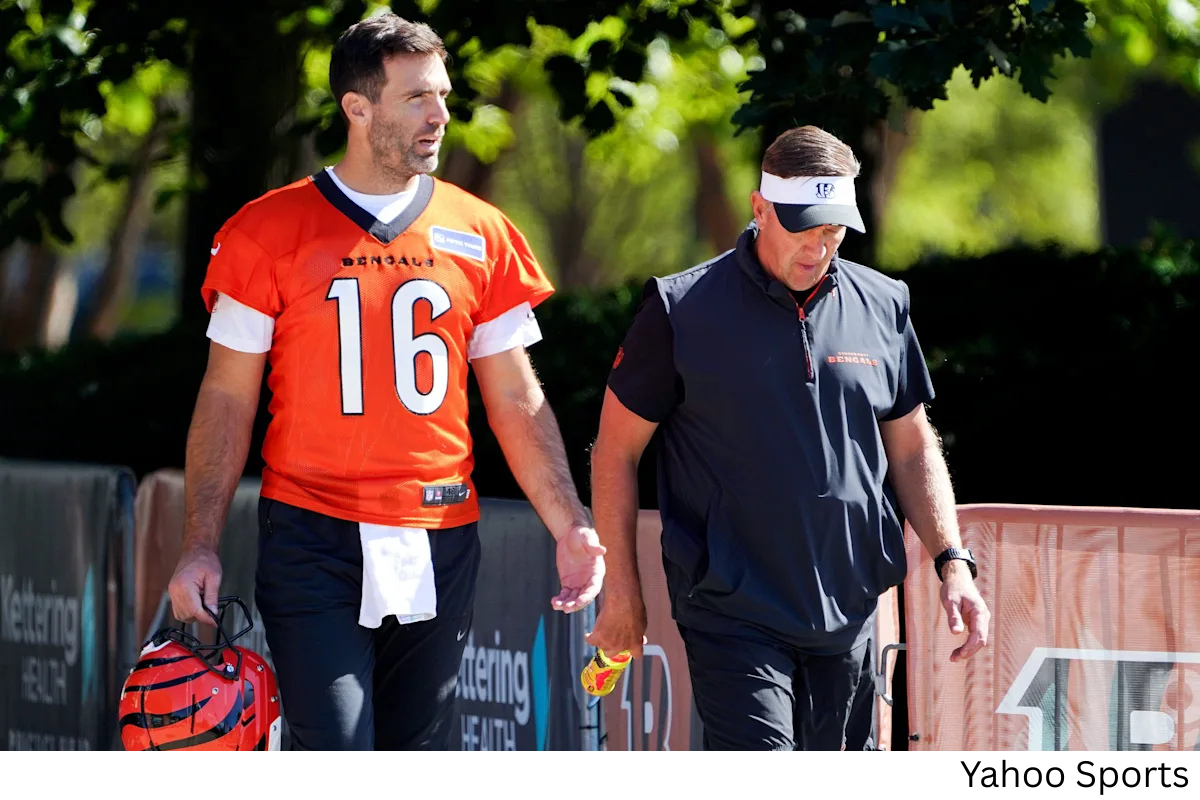Joe Flacco’s arrival in Cincinnati has been a story of connections, credibility, and experience intersecting with a team in need of stability. For a quarterback with 18 years of NFL experience, joining the Bengals just 4.5 days before a game against the Packers could have been chaotic—but Flacco turned it into a masterclass in preparation and leadership.
1. Instant Chemistry Through Shared History
Flacco walked into a locker room where multiple teammates already had indirect or direct experience with him:
- Amarius Mims, his new right tackle, idolized Flacco during his rookie NFL seasons.
- Orlando Brown Jr., a former ball boy and later teammate of Flacco in Baltimore.
- Noah Fant, who caught his first pro touchdown from Flacco.
This shared history created an immediate bond, giving Flacco credibility in a room filled with young talent and veterans alike. According to Ted Karras, center for the Bengals, Flacco’s presence brings a “recipe for success” due to his experience and knowledge of defenses.
Theoretical Lens: Drawing from social capital theory, Flacco’s pre-existing relationships act as a bridge to team cohesion, accelerating trust, communication, and performance alignment in a short timeframe.
2. Preparation Under Pressure
Flacco’s ability to absorb the Bengals’ offensive playbook in just over four days is notable. Chase Brown described Flacco’s command as “almost verbatim” with no mistakes—a remarkable feat given the limited practice time and prior involvement with a different offensive scheme in Cleveland.
Theoretical Lens: This demonstrates expertise transfer theory, where high-level domain knowledge allows individuals to adapt quickly to new environments, mitigating typical learning curves. In practical terms, Flacco’s mental processing of schemes allows him to distribute responsibilities efficiently and reduce errors under game pressure.
3. Leadership and Locker Room Influence
Veterans like Fant and Mims emphasize Flacco’s credibility: he commands respect not only for his Super Bowl win but for his accountability and willingness to help teammates correct mistakes. Leadership in NFL locker rooms often depends on two pillars: performance legitimacy and relational authority, both of which Flacco possesses in spades.
This influence extends beyond X’s and O’s; it helps younger receivers, such as Ja’Marr Chase and Tee Higgins, tap into his timing and anticipation, potentially accelerating their development.
Organizational Insight: Teams acquiring veteran quarterbacks midseason can experience immediate benefits if the player’s presence boosts both tactical execution and cultural cohesion, a principle supported by transformational leadership theory.
4. Challenges and Remaining Questions
While Flacco brings a wealth of experience, there are logistical and roster hurdles:
- Injuries: Left guard Dylan Fairchild and tight end Drew Sample are limited, while Lucas Patrick’s return adds positional flexibility.
- Limited preparation: Only one walkthrough practice to visualize where plays end.
- Integrating a new starter with minimal practice into a high-stakes schedule, including a Thursday night game against the Packers.
The Bengals’ coaching staff must manage both physical readiness and mental adaptation, ensuring Flacco’s experience translates into tangible on-field outcomes without overextending the unit.
5. Strategic Outlook
Flacco’s acquisition is not just a temporary solution; it is a calculated risk designed to:
- Stabilize a 2-3 start and spark offensive productivity.
- Provide mentorship for younger players learning the nuances of NFL game management.
- Offer a short-term, high-upside option without long-term financial commitment.
If successful, this move exemplifies how teams can leverage veteran expertise midseason to realign performance curves.






.png)

